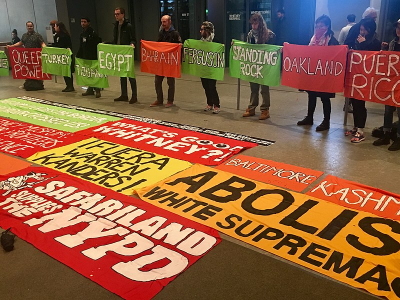April 5, 2019 protest by Decolonize This Place at the Whitney Museum, New York NY, over board vice chair Warren Kanders’ ownership of Safariland, a manufacturer of tear gas and other weapons. Photo: Perimeander. Public Domain via Wikimedia Commons.
My Visit to the Whitney 2019 Biennial by Howard L. Schwartz, MD (08/26/19)
My visit to the 2019 Biennial Exhibit at the Whitney Museum yesterday, while largely foreign to my taste, was successful in its mandate to be provocative and challenging, and by curatorial choices, political with some obvious bias toward hot-button issues in America; large photo-montage images of Colin Kaepernick and black teammates kneeling at nationally televised football game during the playing of the National Anthem in protest draw attention to racial bias today and our national legacy of slavery. The opposing team, all-white, oversized titans of menacingly powerful size, were standing at attention with their hands over their hearts.
This topic was gently discussed over dinner. Why gently? One of my companions thought the art was too obviously political, while I wondered: hasn’t art always been political?
A paper I wrote in college for a two semester course in Government-Political Science was entitled the “The Marriage of Art and Politics in Mexico,” my thesis being that to distinguish art from propaganda is to establish a false, binary distinction. Although I focused primarily on the muralists Diego Rivera and Jose Orozco, I wrote “The marriage of painting and politics was not a happy or lasting one. It seems more than anything else to have been a marriage that was catalyzed by a special social situation . . . art that was aware of and alive to the needs of men in a particular sort of predicament, a predicament induced by political predicaments in Mexico and, more generally, a predicament of modern capitalist civilization.”
Which brings me back to the Whitney and its commentary through wall-art, sculpture, photographs, and performance art. But the garish montages of Colin Kaepernick with the Star Spangled Banner playing in the background at the elevator’s opening to the fifth floor was strictly propaganda, not political art.
Goya, a Spanish painter and printmaker of the early 19th century, depicting the horrors and atrocities of the Napoleonic War against Spanish dissenters, is political art—art that is relevant and alive to a particular situation—war—generally and particularly against those who dissent, as is Picasso’s Guernica in the 20th century.
See El Tres de Mayo by Francisco de Goya from the Prado <https://en.wikipedia.org/wiki/The_Third_of_May_1808>
(See Picasso’s Guernica: June 1937. Now in the Museo Reina Sofía in Madrid:<https://en.wikipedia.org/wiki/Guernica_(Picasso)>
One small image of a tapestry of static on a black and white TV screen titled ‘White Noise’ speaks to our situation in America today. The artist Nicholas Galanin, an indigenous American of the Tingit/Unangax people, part of the Aleut nation that became Americans when the U.S. purchased Alaska from Russia, March 30, 1867. (See https://jimfriedrich.files.wordpress.com/2019/06/fullsizeoutput_7553.jpeg>
Galanin, born in Sitka Alaska in 1979, and still living there, comments in his blurb accompanying the tapestry: “whiteness as a construct has been used historically throughout the world to obliterate the voices and rights of generations of people and cultures regardless of complexion.” This other form of white noise, has in recent years become a “source of increasing intolerance and hate.” –Museum of Anchorage Alaska
So on balance the Whitney 2019 Biennial was worth the visit. It helped me put in perspective my frustration, anger, and disappointment with the racist, white nationalist, misogynist noise on our TVs that we can’t shut off just by tuning off the TV. It’s everywhere.
This tapestry of political art is worth the price of admission alone. But in the bookstore, resting my back before dinner, I noticed a book I’d forgotten I wanted to buy Ninth Street Women, by Mary Gabriel, about five women painters who, against all odds, become successful in a world dominated by men, including their famous husbands, Lee Krasner / Jackson Pollack, Elaine do Kooning / Willem de Kooning, and others . . . launching the “Movement that changed Modern Art.” But yet there is more, that made my visit memorable; as we ate dinner at the window to the Gansevoort street entrance to the museum, we saw hundreds of people, mostly young, lined up for free admission from 7–10 pm to the Biennial. Call me an East Coast elitist, a feminist, and—horror-of-horrors—a bookish nerd, and I’ll say, proudly, “Yes I am.”
Howard L. Schwartz, M.D. is a psychoanalyst and author on psychoanalytic theory and practice, memoirs, stories, and essays, as well as a chapter book of stories for children, and an avid art collector and museum-goer.

